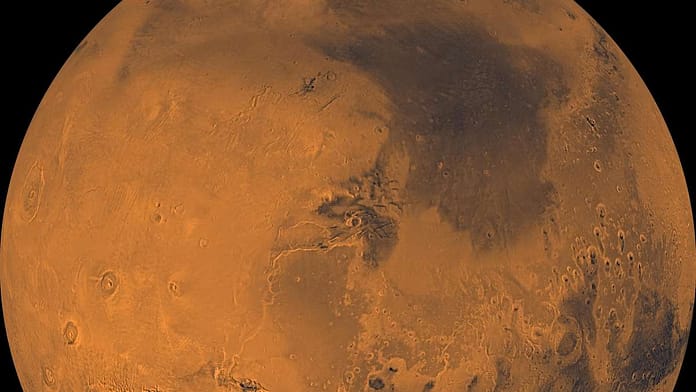Mars has no protective magnetic field and almost no atmosphere. Radiation on the red planet is deadly to humans.
© NASA/JPL
Radiation on Mars is deadly to humans. But now there are new details – thanks to NASA’s Curiosity spacecraft.
Frankfurt – Mars* As a planet next to Earth, it exerts great magic on humanity. In the 1930s, the US space agency wants to NASA* For the first time, an astronaut has been sent to the Red Planet – but one point remains to be resolved: radiation protection for space travelers: Inside.
Since Mars, unlike Earth, has neither a protective magnetic field nor a dense atmosphere, radiation from space can penetrate the surface of the planet unhindered. NASA’s rover, which is currently conducting research there, is not interested in radiation – but it could be fatal to humans.
Radiation on Mars: Some terrain formations can protect people
Therefore, people who are supposed to explore Mars in the future need radiation protection – and it is better that they do not have to travel the long distance from Earth to the Red Planet. The rover Curiosity, which recently discovered a “strange structure” on Mars, appears to have now found a solution to this fundamental problem. That’s what has been suggested at least by a study published in Geophysical Research Letters that is based on data from the NASA Curiosity spacecraft.
Mars has no protective magnetic field and almost no atmosphere. Radiation on the red planet is deadly to humans.
© NASA/JPL
The study by lead author Guo Jingnan (University of Science and Technology in China) and an international research team is working with data from the Radiological Assessment Detector (RAD) instrument on board the Mars rover. It measures harmful radiation on Mars – whether it comes from the sun or other sources. The area that RAD can measure in detail is named after NASA Murray Bates Receipt. ‘Curiosity’ has been parked in this area for 13 days – while the RAD tool continues to collect data. According to the study, these data show a decrease in radiation.
Near the Murray Pots (butt is translated from English as “hardness” – it is a rock that is more resistant than the surrounding area and therefore less corrosive), the amount of radiation has decreased by about five percent. Now five percent isn’t much – but every drop in radiation helps in a challenging environment like Mars.
Mars: Any amount of radiation protection, no matter how small, helps with space travel
There are two types of radiation on Mars: direct radiation that comes from above, that is, from the sun or from space. and indirect radiation that is reflected off the surface of Mars. In terms of indirect radiation, data from RAD also shows something that should be important for future human research on Mars: surface features on Mars that future astronauts can protect from direct radiation can simultaneously amplify indirect radiation. So it is not enough to look for hardy and shelter there – indirect radiation can be increased there.
The new study does not facilitate understanding of radiation conditions on Mars. In addition to conditions that can change the radiation, there is also the distance between Mars and the Sun. Obviously, things as unimportant as the height a person is on Mars or the angle at which radiation penetrates through Mars’ thin atmosphere can also make a difference.
Although the study does not offer a definitive solution to the problem of radiation on Mars, it does provide other methods such as space travel* May work in the future. Any natural radiation protection on Mars should be used for future space navigation missions, or as Universe Today puts it: “Detailed radiation maps that also include terrain could save lives.”
NASA’s ‘Persevere’ rover recently made a name for itself on Mars: It did A rock sample was collected for the first time. Meanwhile, the “persevering” Mars helicopter causes a surprise and causes NASA to change its plans. (tab)* fr.de view from IPPEN.MEDIA.








